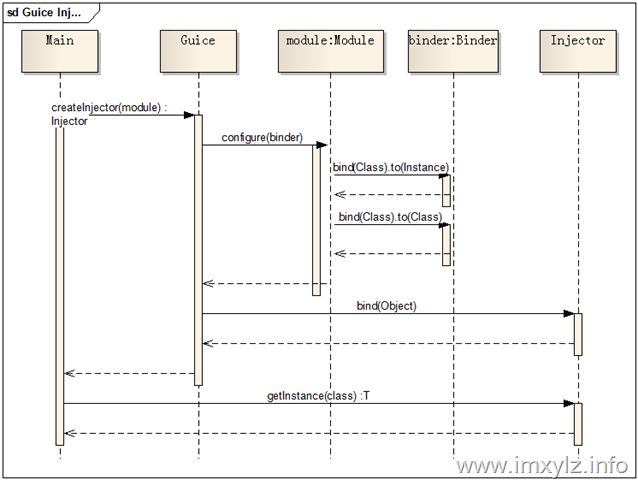6 Guice的IOC容器
6.1 注入过程
在前面的教程中我们讲了Guice注入例子,在使用上具体描述了Guice的注入过程。在下面的篇幅中我们从源码级了解了Guice的注入过程。
我们从具体到抽象再到具体的深入了解Guice的内部运作机制 。
下面一张序列图就是描述了Guice最简单的一次注入过程。比如下面的例子是我们熟悉的。
2 public static void main(String[] args) {
3 Injector inj = Guice.createInjector(new Module() {
4 @Override
5 public void configure(Binder binder) {
6 binder.bind(HelloWorld.class).to(HelloWorldImpl.class);
7 }
8 });
9 HelloWorld hw = inj.getInstance(HelloWorld.class);
10 hw.sayHello();
11 //
12 }
13 }
从上面的图像可以看到我们的核心是Guice如何将我们的实例注入到Injector中的,这样客户端才能在Injector查找我们需要的服务。
我们进入Guice的createInjector方法,看看Guice到底做了什么操作。
return createInjector(Arrays.asList(modules));
}
public static Injector createInjector(Iterable<? extends Module> modules) {
return createInjector(Stage.DEVELOPMENT, modules);
}
public static Injector createInjector(Stage stage, Module
return createInjector(stage, Arrays.asList(modules));
}
public static Injector createInjector(Stage stage,
Iterable<? extends Module> modules) {
return new InjectorBuilder()
.stage(stage)
.addModules(modules)
.build();
}
从上面的代码可以看到我们的Injector是被InjectorBuilder以Builder的模式构造出来的。同时我们也可以注入多个Module,并且默认情况下Guice是以Stage.DEVELOPMENT模式运行的。
在进入我们最核心的InjectorBuilder之前,我们先简化下模型。所谓的IOC容器,或者说DI容器,我们可以看做是一个特殊的Map,这个Map能够将我们的对象按照某种Key(键值)的方式存入,然后客户端能够根据Key来获取我们的对象。因此为了了解Guice容器的内部结构,我们先要了解下Guice容器中存放一个对象的Key到底是什么。
6.2 容器Key
在Guice中用com.google.inject.Key<T>对象来描述一个实例可以对应的Key。
我们可以想象,如果我们以某种类型来从Map中获取结果,那么对于同一种类型每次获取的结果就一样。看似满足需求。但是如果某一种类型对应多种实例怎么办?这种情况下我们就需要我们的Key不仅支持类型,还附带另外一点点东西。Guice是完全基于Annotation的,没有类似spring那样唯一id的概念,于是在Guice中描述一个Key就是靠类型和注解来完成的。在基础教程中我们看到了对于同一种类型,加了不同的注解获取的就是不同的实例。
在Java中每一个对象都有一个类型的概念,即使私有类型比如int,boolean也是有类型的概念,但是自从Java 5推出泛型以后,一直没有一种描述泛型的类型。比如说List<String>在Java中使用List类型来描述的。但是尽管JVM有运行时擦除泛型的特点,却又有能够获取编译前类型的特性,因此实际上List<String>和List<Integer>对于我们来说应该是两种不同的类型。
Guice自创造了一种描述类型的方式,包括泛型类型。在Guice中使用com.google.inject.TypeLiteral<T>类描述所有的类型(包括泛型类型)。我们可以写一个小的例子来看看。
* $Id: TypeLiteralDemo.java 110 2010-01-08 03:06:53Z xylz $
* xylz study project (www.imxylz.cn)
*/
package cn.imxylz.study.guice.inner;
import java.lang.reflect.Method;
import java.util.HashMap;
import java.util.Map;
import com.google.inject.TypeLiteral;
/** a demo for using {@link TypeLiteral}
* @author
* @version $Rev: 110 $
*/
public class TypeLiteralDemo {
public static void main(String[] args) throws Exception{
//
System.out.println(String.format("guice type:%s", TypeLiteral.get(Boolean.class)));
System.out.println(String.format("java type:%s", Boolean.class));
System.out.println();
//
System.out.println(String.format("guice type:%s", TypeLiteral.get(int.class)));
System.out.println(String.format("java type:%s", int.class));
System.out.println();
//
System.out.println(String.format("guice type:%s", new TypeLiteral<Map<Integer, String>>(){}));
System.out.println(String.format("java type:%s", new HashMap<Integer,String>().getClass()));
System.out.println();
//
Method m = Map.class.getMethod("keySet", new Class[0]);
System.out.println(String.format("java type:%s", m.getReturnType()));
System.out.println(String.format("java generic type:%s", m.getGenericReturnType()));
System.out.println(String.format("guice type:%s", TypeLiteral.get(m.getGenericReturnType())));
System.out.println();
TypeLiteral<Map<Integer, String>> mapType = new TypeLiteral<Map<Integer, String>>() {};
System.out.println(String.format("guice type:%s", mapType.getReturnType(m)));
}
}
下面是一次输出结果。
java type:class java.lang.Boolean
guice type:int
java type:int
guice type:java.util.Map<java.lang.Integer, java.lang.String>
java type:class java.util.HashMap
java type:interface java.util.Set
java generic type:java.util.Set<K>
guice type:java.util.Set<K>
guice type:java.util.Set<java.lang.Integer>
从上面的结果可以看出,Java通过一些反射机制描述了部分泛型的类型(使用java.lang.reflect.ParameterizedType来描述,其它类型使用java.lang.reflect.Type来描述,注意Class是实现了Type接口的),但是并不完整,因此Guice重写了这部分。
在上面的类图中我们可以看到,一个key是包含一个类型描述(TypeLiteral)和一个AnnotationStrategy的。AnnotationStrategy是由Annotation以及Annotation的类型组成。而TypeLiteral包含私有类型Class和对Key的引用的。
总之在Guice中是通过类型描述和注解(Key)来完整实例描述的,通过一个Key就我们能够从Guice容器(Injector)中获取我们需要的实例,至于这个实例是单个实例还是一组实例(Set或者Map类型的实例),后面会继续探讨。

